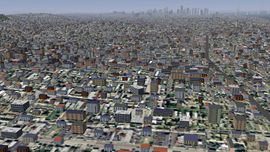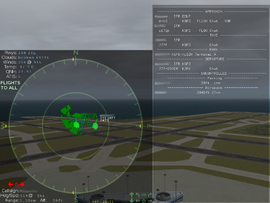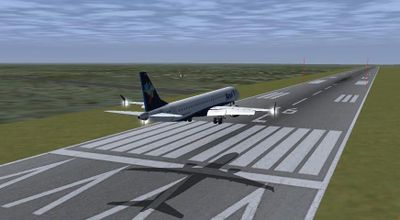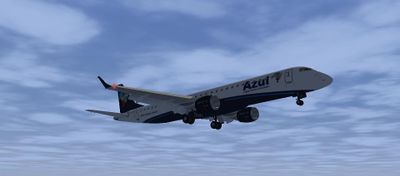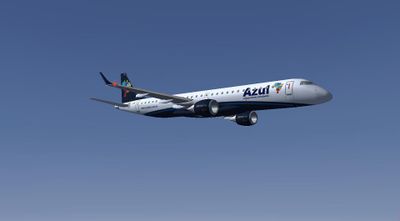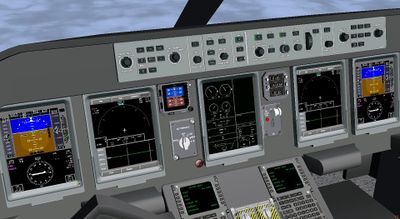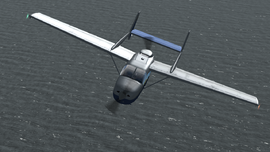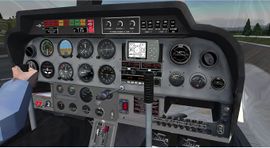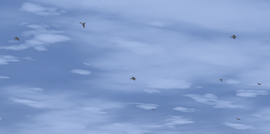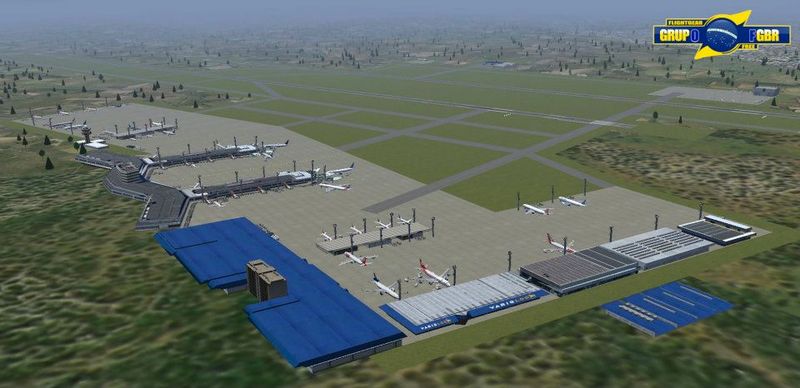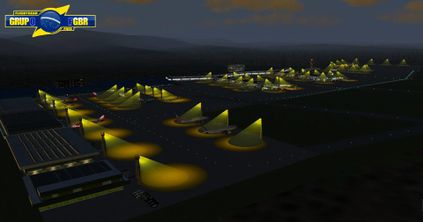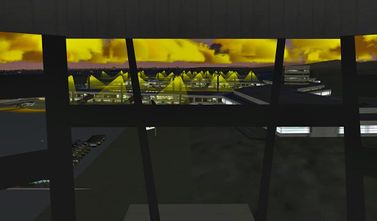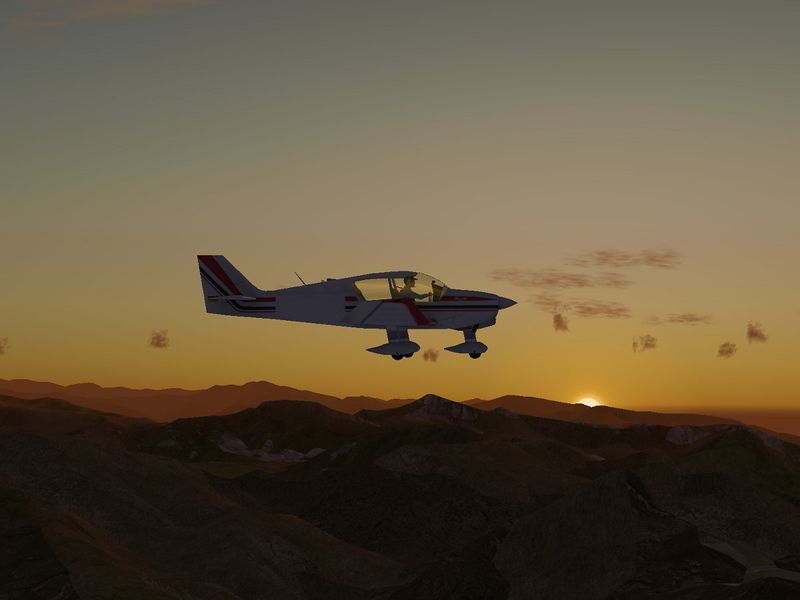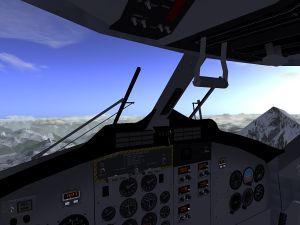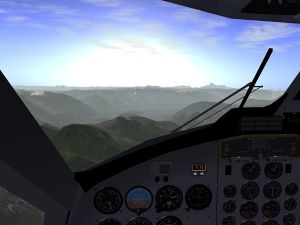FlightGear Newsletter April 2012
|
We would like to emphasize that the monthly newsletter can not live without the contributions of FlightGear users and developers. Everyone with a wiki account (free to register) can edit the newsletter and every contribution is welcome. So if you know about any FlightGear related news or projects such as for example updated scenery or aircraft, please do feel invited to add such news to the newsletter.
Development news
Random buildings
In an effort to improve the scenery in cities, towns and villages with minimal impact to framerate, Stuart has been working on automatically generated "random buildings". The idea is to have FlightGear itself generate buildings with randomized size, shape and texture in a very efficient manner, and builds on the work that he and Tim Moore did on random vegetation a couple of years ago. This is now available in git.
Building generation is configurable through materials.xml, and documented in Docs/README.materials. It is designed to be flexible enough that we can have different types of cities in Europe compared with the USA or Africa. The current texture used for the buildings is a proof of concept, and rather limited by Stuart's artistic abilities. If anyone is interested in creating a better texture, please get in touch with Stuart on the mailing list or forums.
One of the main aims of this work is to minimize frame-rate impact. If you are running git, and have the time to test the new feature, please fill in this poll on the forums so we can gather information on whether it has succeeded. Read more at Random Buildings.
Additional scripting APIs
Several advanced aircraft have created Flight Management System (FMS) and Control Display Unit (CDU) implementations using custom Nasal code to model modern airliner/bizjet avionics, with some (or no) interaction with the already existing route manager implemented in C++, and often with code that overlaps.
There's now an effort to improve this, while keeping the complex, especially aircraft-dependant functionality in Nasal so it can be tailored and extended easily. Work has started on improving the existing Nasal scripting interface such that modern avionics can be more easily modeled in scripting space, for additional information please check out Nasal Flightplan.
Interview with a contributor (Sam Clancy)
In each edition we have an interview with a contributor. Suggestions for possible questions are available on interview questions, you are invited to come up with new questions and interview ideas obviously! Anyone is free to write an interview (with him-/herself or others) for next month's newsletter!
Read previous interviews at our website's archive.
- How long have you been involved in FlightGear?
Actively I've been involved with the FlightGear project since early January 2011. Simply because my old computer (which my family had had for about 5 or 6 years prior) couldn't run FlightGear. But after we upgraded... (insert evil laugh here)
- What is your forum nickname?
connect is my name.
- What are your major interests in FlightGear?
Flying, first of all. My life dream is to become a commercial airline pilot, hopefully somewhere in Europe. I've taken my very first steps towards this in real life, with my "TIF" or Training Introductory Flight, but I also believe my prior experience FlightGear, and of course my continued use of FlightGear gives me a much cheaper alternative, for the time being, to gain experience.
- Why is it that you are interested in flight simulation or aviation in general?
The fact that it took mankind literally thousands of years to figure out how to fly, in just a century we've gone from the Wright Flyer all the way to the Antonov An-225, the Airbus A380, the Boeing 747, the list is endless. I think the fact we got to the moon is pretty good to.
- What project are you working on right now?
I think you mean projects, in my case. I've actually got three on the go; all of which I am collaborating on (something I love with FlightGears community spirit). They are; the Airbus A350-900XWB in co-operation with Malik Guest (tehwarlock). The Jabiru J-170 (the aircraft I completed my "TIF" or Training Introductory Flight in) with Narendran Muraleedharan (Omega Pilot/Omega95) and Project Brisbane, perhaps the most ambitious, with Lachlan Bruce (spitfirebruce21), Drew Gibson (VH-TIT/FlightGearNZ) and Malik Guest (tehwarlock).
- What do you plan on doing in the future?
I actually don't know. I just hope I can develop my skills enough to contribute something really good to the FlightGear Project.
- Are you happy with the way the FlightGear project is going?
Overall; yes. Having come in the days of v2.0.0 and at one stage, using 0.9.0, it's blatantly obvious the progress that has been made in the year or so I've been actively involved in the community.
- On average, how much time do you spend working with/contributing to FlightGear?
A day? Hours. Note the plural form of the word. I don't have a number, as I'm frankly not pedantic enough to record, but I assume it'd scare me.
- Which of the more recent FlightGear developments do you consider most interesting/appealing?
Thorsten's Local/Advanced Weather; I use it everytime I fly. It's alot nicer visually then the "Global/Simple Weather" and I think it competes with FSX and REX.
- What do you enjoy most about developing for FlightGear?
The satisfaction you get when something works! Maybe that's because I'm not the most technically minded, hehe.
Read previous interviews at our website's archive.
In the hangar
All the way back in May 2011, we addopted a new status-rating system for aircraft. So far, only a few have actually been rated, as can be seen in the list 'hockenberry' set up at Google Docs. If you're an aircraft developer and your aircraft is/are not on the list, please consider rating their status. All you'll need to know/do is described at Formalizing Aircraft Status. If you'd just like to get started contributing to FlightGear, this would also seem like an excellent way to get started.
New aircraft
ATC FS: A new ATC mode for FlightGear
ATC-FS (ATC, with flightstrips) is an air traffic control (ATC) aircraft, with the purpose to help an ATC controller keeping track of the aircraft around his airport as well as helping him guide the aircraft on approach and departure and aircraft just passing through his airspace. It can be added to FlightGear just as a regular aircraft and is built with XML and nasal. Read more at ATC-FS.
Embraer 195
A new Embraer 195, developed by the Brazilian group FGBr for FlightGear version 2.4 and 2.6 can soon be found at at: their website.
Updated aircraft
Cessna 337G Skymaster
The Cessna 337G Skymaster received an update, making the plane ready for FlightGear 2.6 and some more nice improvements. The Skymaster now has an autostart function, new autopilot, checklists and "utility" dialogs, new heading indicator, 2 new liveries, new splash screen, new cockpit animations and new shaders, and a complete new ELT system. Some more? Well, the 337G is now able to crash due for hitting the ground or excesive G loads.
Thanks to these updates, this aircraft was chosen to be Aircraft of April. Scroll down to Aircraft of the month to watch the video review.
MiG-21bis
MiG-21bis had a major update; 3D model is cleaned and remaped, new texture is added. Cockpit is remodeled and it has new instrument arangement. Aditional weapons are added with full Bombable support. Small fixes in FDM include more efficient flaps and hardpoint weights.
Zivko Edge
The Zivko Edge by Torsten Dreyer was already a great airplane, Jentron worked the FDM over and now its quite capable of tumbling and spinning with rough handling.
Garmin 196 GPS
The PAF team is proud to announce the arrival in git of the Garmin 196 GPS instrument. This GPS fits perfectly into light aircrafts such as the Robin DR400, microlight aircraft or helicopters. The source code is available in the fgdata repository.
To include this GPS in your aircraft, simply follow those guidelines. A full howto is also available here, while a thread on the international forums has been opened.
Scenery corner
Birds in FlightGear
Written by VicMar
Every so often I get fed up modelling buildings, so I think of other (often silly) things I can model for FlightGear. I have already made several low-poly models which can be used with AI scenarios. This time I have created an animated seagull.
By attaching him, and variations of him, as sub-models to an invisible rotating base, you can have several seagulls circling above any model which has an .xml file.
There are two standard sub-model entries which can be added individually or together to an existing model’s .xml file. Each will add four seagulls:
<model>
<path>Models/Fauna/SeaGull_Origin.xml</path>
<offsets>
<x-m> 0.0</x-m>
<y-m> 0.0</y-m>
<z-m>15.0</z-m>
</offsets>
</model>
The above option is already available. An other model, that can be added by changing the <path> to Models/Fauna/SeaGull_Origin_2.xml, has been sent for inclusion in the model database, and should be available very soon.
These entries can be altered to your own preference, or if you so wish you can alter the individual seagull variations, which can be found in $FG_ROOT/Models/Fauna.
Who says we have to be serious all the time? Have fun and enjoy!
TerraGear
As you might be aware there is constant genapts850 development going on, to bring the apt.dat 850 format features (and beyond) to FlightGear. This work has now been merged into the official TerraGear git repository for general consumption. Work is still ongoing to bring in missing features like some special light variants, runway shoulders and different textures. Some bad bugs have been fixed recently and there are even Windows binaries available from our build server.
Scenery Data
Data with the explicit use of being turned into FlightGear scenery has now been vectorized for almost all of California, western Oregon, parts of the Grand Canyon in Arizona, Las Vegas, Colorado, and northern New Mexico. This product is not yet available in terrain form, but represents good progress toward having nicer United States scenery data.
Aircraft of the month
Because of its very nice latest developments, the Cessna 337G Skymaster has been chosen to be Aircraft of April.
Airport of the month
International Airport of Guarulhos (SGBR) in Sao Paulo City, Brasil is available for download at [www.grupofgbr.com.br grupofgbr.com.br].
Screenshot of the month
FlightGear is going to simulate the effect of air pollution - with some air pollution, sunrise colors become a lot more spectacular, as demonstrated here by a DR-400 experiencing a sunrise flying close to Nice (France).
Suggested flights
Central Karakoram range
Let's explore one of the highest regions of the planet - the central Karakoram with the densest concentration of mountains of 8000 m and above. We're going to need a good climbing performance for the trip - even the frozen plateau of Baltoro glacier, above which K2 and Gasherbrum V and VI loom, is more than 13,000 ft high.
Take off from Skardu airport in Pakistan (OPSD). Skardu has a reasonably long (11,944 ft) runway at just 7,316 ft elevation, so you can take a jet, but for instance the Twin Otter is more stylish.
South of Skardu lies Deosai park, a famous high plateau, but we turn initially east. There's a chain of lakes which is the Indus river. After about five miles, the Shigar river merges with the Indus. Turn slightly left and follow the Shigar, then follow it into a long and broad lake-filled valley stretching into north-western direction.
Towards the end of the lake, a small tributary river, the Braldu, turns eastward out of the main valley. Follow the Braldu and start climbing (if you haven't done so yet). About 15 miles after turning into the Braldu river valley, two glacier-filled valleys stretch to the north - admire the view!
Passing a few lakes, you reach finally Baltoro glacier continuing the river valley stretching eastward. Ever climbing, follow the glacier till you reach some kind of T-junction. The glacier arm reaching north leads to K2 (which sadly isn't really there in Flightgear), but just ahead of you are the still rather impressive peaks of Gasherbrum V, VI and I - circle the range and make some pictures!
A good way back to Skardu is to go about 10 miles sourth from the Gasherbrum peaks, then head due west. To your west, you can see the long valleys fall away from the high ranges, to your right is the still glacier-covered high Karakoram. On a clear day (really good visibility selected) you can see the distinctive peak of Nanga Parbat appearing straight ahead on the horizon. The valley of Skardu is quite a distinctive feature and finding back VFR should not be a problem.
Wiki updates
Throughout April, various aspects of the wiki have been changed or updated. The wiki software is now running the latest stable release, providing better security and usability. A side effect of this update is a bunch of new features, together with some new extensions that were installed.
Some of the most noticeable changes include:
- The upload wizard guides you through the process of uploading files. It provides an user interface to fill in the information template that we discussed in the previous newsletter edition. And should therefore help us archiving files in a way that they can be easily found back and used among the wiki and other places. Please remember to categorise your file(s)!
- Vector is the new default style of the wiki. It comes with a more advanced search box (moved to the top right of the page), showing suggestions of articles that you might be looking for.
- A new editor provides a more extensive interface for editing articles online.
- Aircraft categories have been cleaned up and now match the categories on (the English) Wikipedia. Please see Category:Aircraft for an overview of available categories, before categorising an aircraft article. No aircraft articles should be categorised with
[[Category:Aircraft]], use the subcategories instead!
At the same time the portals and main page have been redesigned, providing a cleaner and more attractive look. Over the last four years, the portals became long lists of links (some links even managed to get listed three times in the same portal), making it hard for anyone to find what he/she is looking for. The new portals are far from complete; in the upcoming week(s), all old links will be reconsidered and, when appropriate, re-placed in one of the portals.
Feedback on all of this is extremely appreciated! Feel free to share your thoughts in the (new) Village Pump.
Useful link
- www.aircharts.org provides fast, simple access to aerodrome charts. This includes STIDs, STARs, Approach Procedures, IAPs and the ICAO-standard aeordrome chart itself. It also provides en-route charts for the USA and most of Europe. IFR flight planning just became a lot easier!
And finally ...
Contributing
One of the regular thoughts expressed on the FlightGear forums is "I'd like to contribute but I don't know how to program, and I don't have the time". Unfortunately, there is a common mis-conception that contributing requires programming and lots of free time. In fact, there are a huge range of ways to contribute to the project without needing to write code or spending days working on something.
For ideas on starting to contribute to FlightGear, you may want to check out: Volunteer.

